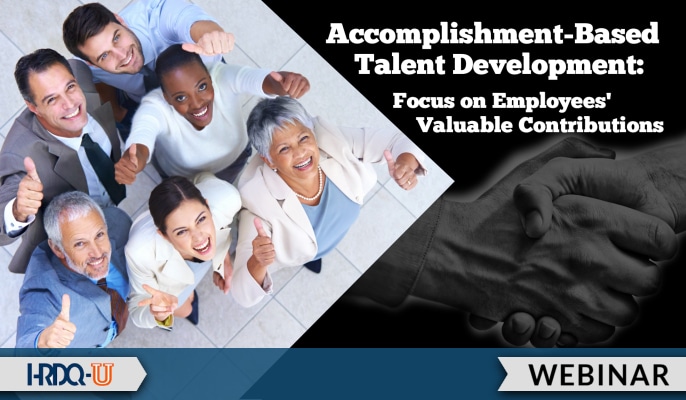Thus, to be accomplishment-based is to focus talent development, HR, management, and leadership on the valuable products or contributions that people produce in pursuit of their organizations’ business results. Work outputs might be concrete deliverables, such as widgets or documents. They might be less tangible things, such as decisions or relationships. They might include products of innovation, such as new ideas, prototypes, or models, or accomplishments of various communication efforts, such as appointments from phone calls, decisions at the end of meetings, questions at the end of presentations, etc. For trainers and managers, key accomplishments are people who can do or produce particular things. In any case, accomplishments are countable nouns, and we can establish criteria for each accomplishment to determine whether it is a “good” one or not.
The ramifications of being accomplishment-based are that we drive all efforts to develop and manage people based on their valuable contributions. We can create job profiles by listing the accomplishments that the job contributes and the internal or external customers to whom it delivers those accomplishments. When onboarding new people, we plan their early weeks and months based on what accomplishments are most important to master and then stage the development of their capacity to deliver those accomplishments over time. When we design training programs, we list the objectives of those programs as accomplishments. “At the end of this program, you will be able to produce better decisions, relationships, widgets, assemblies, proposals, etc.” instead of “you will know . . .“ or “will you will be able to do. . . .” When we mentor or coach people in this way, we focus on the valuable accomplishments they must be able to produce and help by providing all the factors that will help them do so. When we consider promotion, re-assignment, or succession planning, we define the accomplishments needed in each role or stage of development.
This approach has enormous benefits. First, we can measure and evaluate performance objectively by counting the accomplishments people produce rather than subjectively rating them on abstract competencies (which are actually categories of behavior). When training, we can enable people to produce the things or components of the things they will actually be required to contribute on the job. This means that we can transition individuals and groups to be managed and developed by their supervisors or managers, prepared to deliver what’s needed rather than needing to turn “knowledge” into performance. In short, all parts of the organization, from HR to Operations, can focus on the same valuable contributions expected of people.
Drilling down in a little more detail, a focus on countable accomplishments makes training and management much leaner and more cost-effective. When we know the specifics of what trainees or individual contributors must produce, it’s easier to focus on the behavior needed to produce them rather than on broader and more abstract sets of skills and knowledge. Our training designs can often become simpler and leaner, and it’s easier to provide additional support in the form of clear expectations, feedback, tools, and recognition for producing those things. Trainers, HR, and managers can collaborate more easily. And from the perspective of the individuals themselves, being shown exactly what they are expected to produce sets clear expectations and supports clearer, more explicit feedback about what is good and what needs improvement. In the same way, an accomplishment-based approach supports the creation of focused behavioral interviewing questions and performance tests during the hiring process.
We can, in short, design an entire process of Talent Acquisition and Development, from recruiting and hiring to ongoing development and promotion, based on the accomplishments expected from a given job and from each person in that job. Far more focused and clarifying than the typical competency-based approach, defining performance starting with accomplishments promises a more cost-effective and sure-footed way to manage and develop people.

















One Response
This is well articulated and drives home the point that developing a productive and effective organization requires focus on the outcomes needed from that organization. Good mgrs must work backward to determine what it takes to be successful.